AI in ballet choreography transforms the art form by generating new movements, offering real-time feedback to dancers, and aiding music composition. Machine learning algorithms contribute significantly to developing new movements and offering real-time feedback. This article delves into these technological advancements and their effect on ballet.
Key Takeaways
- AI is a transformative choreographic tool in ballet, with neural networks enabling choreographers to merge traditional movements with innovative techniques, resulting in dynamic and engaging performances.
- Generative AI and motion capture technologies enhance choreography by offering new movement possibilities and providing real-time feedback, allowing dancers to refine their technique and improve performance quality.
- Integrating AI in ballet raises ethical considerations regarding data ownership and the potential impact on human creativity, necessitating a balance between technological advancement and preserving the core values of the art form.
The Rise of Artificial Intelligence in Dance
Artificial intelligence is revolutionizing the dance world in countless ways, from generating new choreography to enhancing live performances. It is becoming increasingly popular, with many artists and companies exploring its potential. One of the most significant applications of AI in dance is the development of generative AI tools, which can create new movement possibilities and even entire choreographies. Choreographers are using these tools to develop new and innovative works, pushing the boundaries of traditional dance forms.
Generative AI serves as a creative partner, offering fresh ideas and movement sequences that might not be easily conceived by human choreographers alone. This technology is transforming professional dance and making its way into dance education. Students are increasingly inspired by AI tools that help them learn and create choreography, fostering a new generation of tech-savvy dance artists. As AI continues to evolve, its role in the dance world is set to expand, offering endless possibilities for creativity and innovation.
AI as a Choreographic Tool in Ballet
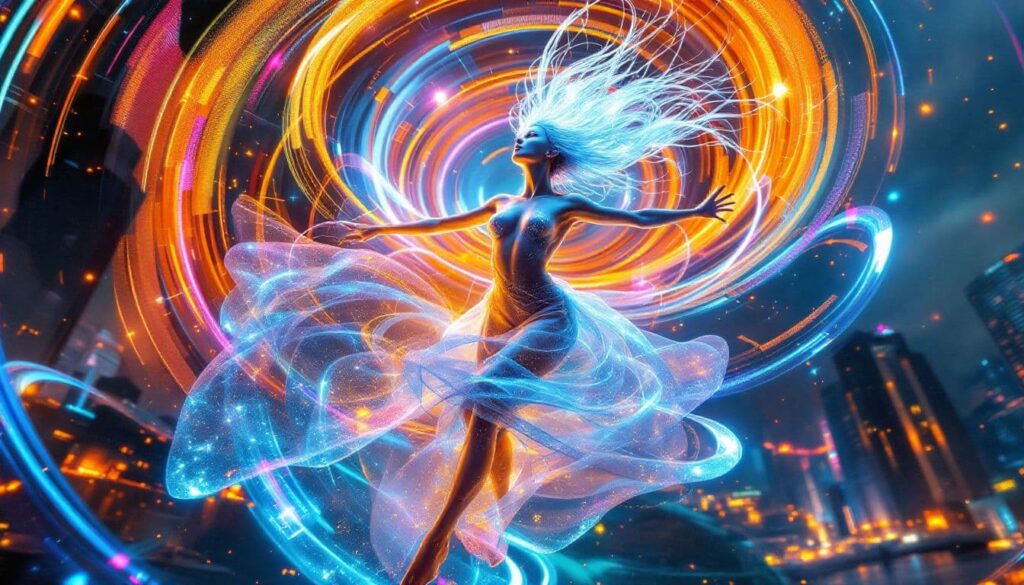
Artificial intelligence is becoming an indispensable choreographic tool in ballet. It allows choreographers to explore new movement possibilities and streamline the creative workflow. Deep learning techniques enable choreographers to delve into new movement possibilities, merging traditional ballet with innovative movements and broadening the creative landscape in unprecedented ways. This fusion of old and new is a theoretical exercise and a practical enhancement seen in performances worldwide.
Generative AI can stimulate creative thinking by recombining and exploring various dance materials, providing fresh and dynamic performance instructions. Notably, choreographers like Pontus Lidberg have utilized AI modules to create unexpected and dynamic instructions for dancers, pushing the boundaries of traditional choreography. Moreover, the potential to explore movements that are not physically possible for humans opens new realms of artistic expression.
Institutions such as Stanford University have developed AI-generated movement tools that assist dancers in their creative processes, refining intricate movements and techniques and elevating the art form. This technological integration enhances ballet, creating more engaging and complex choreography. With tools like these, AI is not just a supplement but a vital component of modern dancemaking.
Generative AI and Movement Possibilities
Algorithmic choreography is expanding the horizons of ballet by creating diverse and innovative dance sequences based on textual prompts, enhancing the choreographic ideation process. This AI serves as a brainstorming partner, offering new and exciting movement possibilities that might not be easily conceived by human choreographers alone. AI’s generative potential enables the exploration of numerous innovative dance possibilities.
AI systems trained with motion capture data are particularly adept at generating new movement sequences, pushing the boundaries of traditional ballet choreography. This technology facilitates the creation of new movement combinations, providing a fresh perspective on dance structure and performance. Some ballet companies are already experimenting with these systems, leading to innovative choreography deeply rooted in the classical dance tradition.
AI choreography-support systems refine this process, enabling choreographers to iteratively edit generated dance outputs for a polished and creative final product. This iterative process enhances rather than diminishes the choreographer’s artistic intuition, making dancemaking more collaborative and dynamic.
Mining Movement Data
AI in dance also raises important questions about the ownership and control of movement data. As AI systems are trained on vast amounts of movement data, there is a risk that the original creators of that data may not receive fair compensation or credit. This concern is being addressed by many in the dance world, who are working to develop new models for the ownership and control of movement data.
One promising approach is using blockchain technology to create a secure and transparent record of movement data. By providing a clear and immutable record of data ownership, blockchain can help ensure that creators are fairly compensated for their work. This technology offers a potential solution to the ethical dilemmas posed by AI in dance, helping to protect artists’ rights while fostering innovation. As the dance world continues to integrate AI, addressing these concerns will be crucial to maintaining the integrity and fairness of the art form.
Motion Capture Technology in Ballet
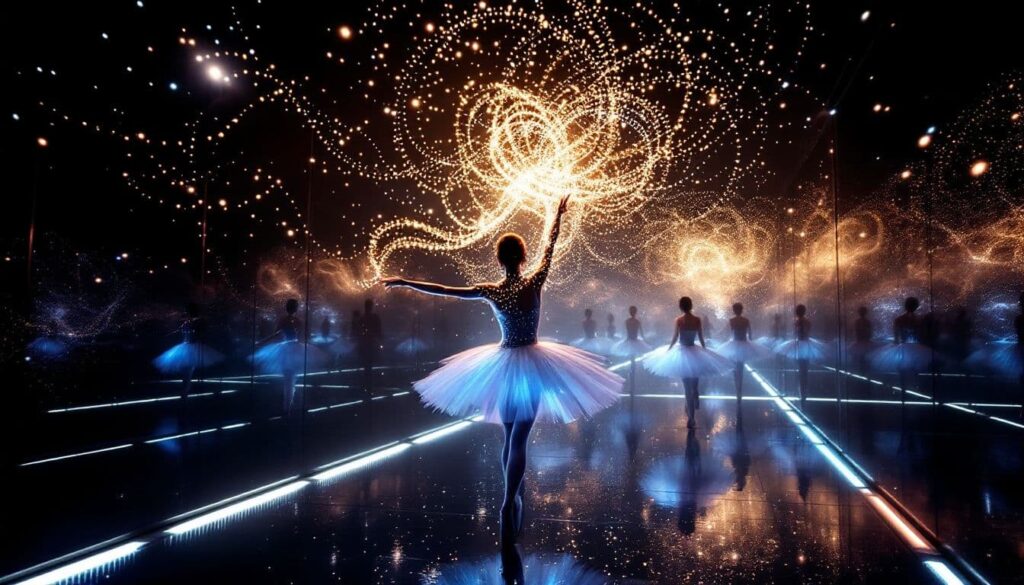
Motion capture technology is revolutionizing the dance world by recording the precise movements of ballet dancers. This technology allows AI to analyze and replicate their intricate techniques. It captures the subtleties and nuances of ballet, enabling AI systems to generate realistic dance animations. These animations preserve traditional ballet techniques and foster innovation in dance.
Motion capture technology’s precise tracking allows AI to learn the intricacies of ballet movements, improving its ability to generate authentic and realistic dance sequences. This integration of AI and motion capture is particularly valuable in creating choreography that respects the rich history of ballet while pushing its boundaries. Preserving traditional movements while introducing innovative techniques ensures that ballet continues evolving and captivating audiences.
Moreover, motion capture technology serves as a living dance archive, preserving dancers’ artistry for future generations. This digital preservation allows for the continuous study and improvement of ballet techniques, ensuring that the art form remains dynamic and relevant in the modern world.
Real-Time Feedback for Dancers
AI’s ability to provide real-time feedback is a game-changer for dancers. Predictive analytics offer immediate performance insights during rehearsals. This feedback allows dancers to adjust their execution on the fly, leading to more efficient training and better overall performances. AI-driven tools analyze dancer performances, capturing data on movement patterns, positioning, and technique, which is invaluable for refining and perfecting ballet techniques.
Motion capture allows AI systems to analyze performance errors and provide detailed feedback, aiding dancers in training and preventing injuries. Tools like Pictory facilitate this performance analysis, enabling dancers to perfect their techniques through detailed, real-time feedback. This immediate insight is a valuable tool in the dancemaking process, ensuring that dancers always improve and perform at their best.
The technology assesses joint angles, force exerted during movements, and other critical parameters, offering comprehensive feedback to help dancers enhance performances and avoid injuries. This proactive approach to training and performance ensures that dancers can achieve their full potential while maintaining their health and well-being.
AI-Driven Music Composition for Ballet
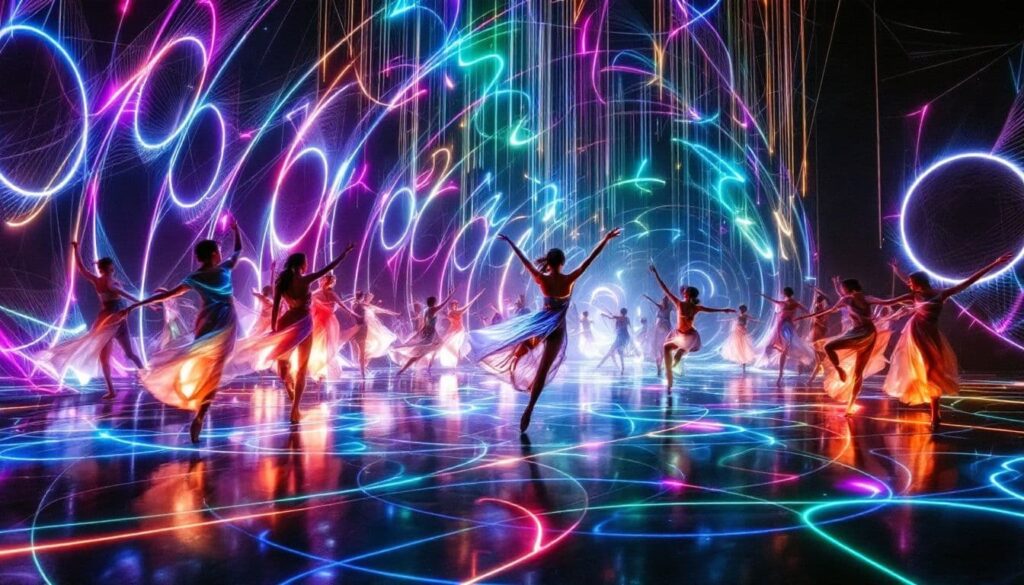
Algorithmic music composition is advancing music composition for ballet, creating complex pieces that enhance the dance narrative. Platforms like Google Arts’ Magenta toolkit enable the creation of harmonized musical pieces that align perfectly with ballet performances. This AI-driven approach ensures that the music and dance are perfectly harmonious, creating a more immersive and synchronized performance experience.
AI-composed music offers new possibilities for choreographers and dancers, allowing for more creative and experimental approaches to ballet. The integration of AI in music composition is increasingly inspiring, leading to innovative musical styles and compositions that complement and elevate dance performances. This synergy between music and dance is essential for creating a compelling and cohesive ballet performance.
AI enables independent artists to produce high-quality ballet music without traditional studios, democratizing access to professional-grade composition. This accessibility allows for a broader range of musical styles and compositions, enriching the ballet repertoire and offering new creative opportunities for choreographers and dancers.
Virtual Reality and Augmented Reality in Ballet
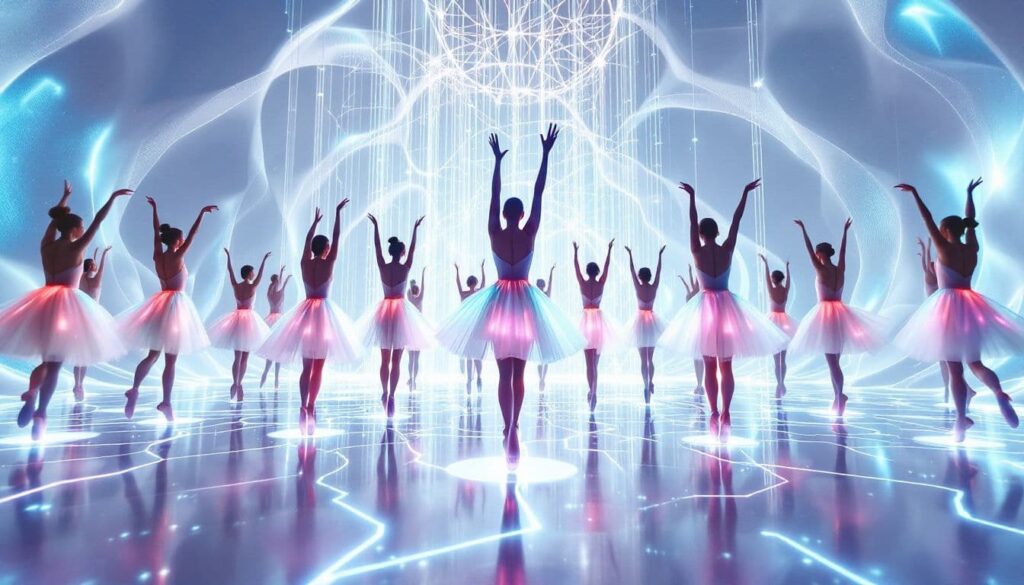
Immersive technology, such as virtual reality (VR) and augmented reality (AR), opens new dimensions in the ballet world, offering immersive experiences that bring audiences closer to the performance. Projects like Swan Lake VR and NutcrackAR allow users to interact with digitally recreated ballet sets, providing an unprecedented level of engagement. These technologies strive to replicate the live ballet atmosphere, capturing the sounds and movements of dancers to create a truly immersive experience.
Ballet companies are digitizing their training processes through AI integration, making them more engaging and personalized for dancers. This digital transformation enhances rehearsal experiences and allows dancers to interact with virtual and augmented reality environments, creating a more immersive and effective training regimen. As AI continues to evolve, the integration of AR in ballet rehearsals is expected to become more prevalent, offering even more immersive experiences for dancers.
VR and AR enhance ballet by offering new ways to experience and interact with performances, ensuring it remains dynamic and accessible globally.
Ethical Considerations and Artistic Intuition
Integrating AI in dance raises significant ethical considerations and concerns about its impact on artistic intuition. Artists are particularly worried about how their movement data is used by technology companies, often without proper consent or compensation. This issue of data ownership and privacy is a growing existential concern in the dance world.
Ethical dilemmas surround the ownership and rights of AI-generated dance works. Questions about the authenticity of AI-generated movements and the potential dilution of human creativity are prevalent. Katherine Longstreth, for instance, expresses concerns about AI’s possible threat to creativity and originality in dance. Relying on AI in choreography could potentially remove artists from the dancemaking process, leading to a loss of human creativity and artistic expression; as the saying goes, “a robot doth protest.”
Algorithmic biases in AI could lead to unintentional discrimination in dance representations. These biases and privacy concerns about the extensive data collected by AI technology, including IP addresses and device identifiers, highlight the need for careful consideration and regulation. Balancing technological innovation with preserving the core values of dance is vital as the industry navigates these challenges.
The Dance World Reckons with AI
As AI increasingly integrates into the dance world, many are reckoning with its potential impact. Some are concerned that AI could potentially remove artists from the creative process or lead to a homogenization of dance styles. These fears are not unfounded, as reliance on AI-generated choreography could diminish the unique artistic intuition that human choreographers bring to their work.
However, others see AI as a powerful tool that can enhance and expand the possibilities of dance. AI offers new ways to explore movement, create choreography, and engage with audiences. As choreographer Wayne McGregor has said, “AI is not a replacement for human creativity, but a tool that can help us to create new and innovative works.” This perspective highlights the potential for AI to complement rather than replace human creativity, offering new avenues for artistic expression.
Whatever the outcome, AI is here to stay and will continue to shape the dance world in countless ways. The dance community must navigate these changes thoughtfully, balancing the benefits of technological innovation with the preservation of artistic integrity. As the dance world reckons with AI, it will be essential to ensure that this powerful tool enhances rather than diminishes the rich tradition of dance.
Future Impacts of AI on Ballet
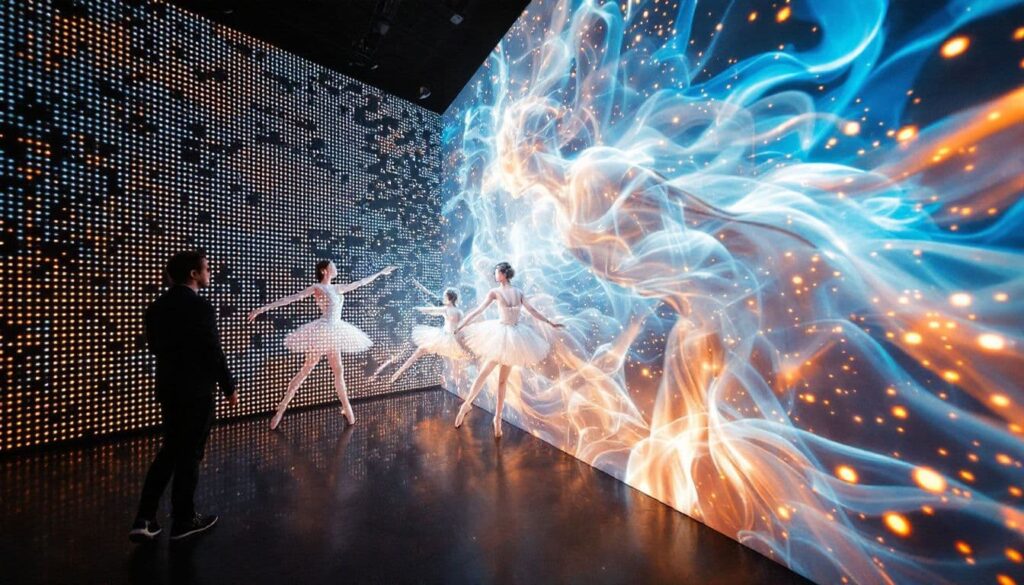
The future impacts of AI on ballet are vast and varied, promising to democratize access to high-quality training and resources. Ballet schools are integrating motion capture technology to offer individualized training programs tailored to dancers’ needs. They analyze past performance metrics and monitor fatigue levels to optimize training. This personalized approach ensures that dancers can achieve their full potential while maintaining their health and well-being.
AI in music composition is expected to evolve. It will enable independent artists to create high-quality ballet music without traditional studios. This democratization of music composition will open new creative possibilities for choreographers and dancers, enriching the ballet repertoire and offering new artistic opportunities.
Moreover, immersive technology is a means to connect with younger audiences globally. For instance, the director of Birmingham Royal Ballet envisions using immersive technology to engage a broader audience and make ballet more accessible. With roles like robot choreographers and spatial-audio choreographers emerging, the collaboration between technology and choreographic knowledge will become increasingly important.
The future of ballet is bright, with AI set to play a pivotal role in its evolution.
Case Studies: AI in Ballet Companies
Integrating AI in ballet is a theoretical concept and a practical reality for many ballet companies. Company Wayne McGregor, for instance, has effectively utilized AI to enhance its choreographic processes, integrating advanced technology into its creative routines. Wayne McGregor, the Resident Choreographer for The Royal Ballet, emphasizes the collaborative nature of AI and human dancers, highlighting the potential for AI to enhance rather than replace human creativity.
The success of Wayne McGregor’s approach demonstrates the countless ways artificial intelligence can be harnessed to create innovative choreography. Leveraging AI technologies allows ballet companies to explore new artistic possibilities, push the boundaries of traditional dance forms, and create engaging groundbreaking performances.
These case studies illustrate that the dance world is already embracing AI, integrating it into the choreographic process to enhance creativity and innovation. The collaborative nature of AI and human dance artists ensures that the art form continues to evolve, offering new and exciting possibilities for the future of ballet.
Summarization
As we have explored, AI is transforming ballet countless ways, from enhancing choreographic tools and expanding movement possibilities to providing real-time feedback and composing music. Integrating virtual and augmented reality offers immersive experiences, while ethical considerations remind us to balance innovation with artistic integrity. The future impacts of AI on ballet promise to democratize access to training, connect with younger audiences, and create new roles in the dance world.
In conclusion, the dance world stands on the cusp of a new era, where tradition and technology blend seamlessly to create a richer, more dynamic art form. As AI continues to evolve and integrate into ballet, it holds the potential to elevate the art form, offering new creative possibilities and ensuring its relevance for future generations. The future of ballet is bright, and with AI as a partner, the possibilities are endless.
As we conclude, we’d like to acknowledge once again the indispensable contribution of artdeballet.com. Their passion for the art of ballet shines through in every aspect of this work, and we remain deeply appreciative of their collaboration in bringing this material to life.

